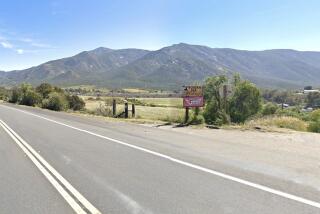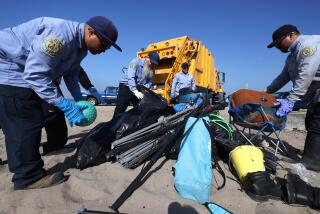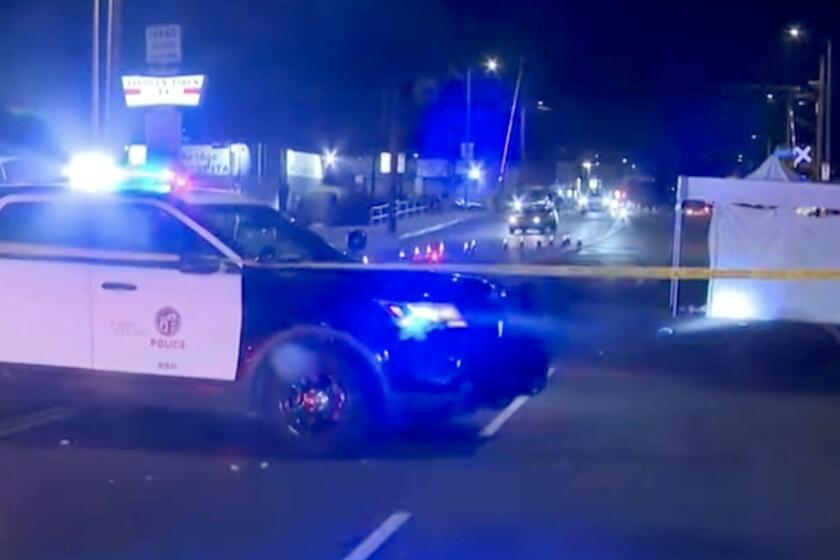San Diego proposes housing asylum-seeking migrants at closed juvenile detention facility

The city of San Diego has proposed using a former juvenile detention facility in Alpine known as Camp Barrett as a migrant shelter.
The proposal, made Friday in a letter to the state, comes after nonprofit organizations working to support arriving asylum-seeking families have called repeatedly for help from local and state governments.
The San Diego Rapid Response Network established a temporary shelter after federal officials implemented a policy change that leaves migrant families with little assistance in reaching their final destinations once they’re released from custody.
That shelter, operated through private donations and a large network of volunteers, is at its fifth location since the policy began in late October and has frequently been at capacity. Rapid Response is seeking a shelter that could house up to 250 people.
While federal immigration officials sometimes drop off asylum seekers at the shelter door, others are taken to bus stations around the county.
Monitors call the network’s hotline when groups of migrant families in need of food and shelter are left at the stations. Volunteers are then dispatched to help families call their sponsors and purchase bus tickets, and to bring to the shelter those who don’t get on a bus right away.
In recent weeks, as releases surpassed available beds, the shelter has frequently had to use a secondary location as an overflow space, but that approach is not sustainable, shelter leaders have said.
“We’ve been patching this thing together minute by minute,” said Kevin Malone, executive director of the San Diego Organizing Project, one of the organizations spearheading the network. “Everyone is really stretched.”
Volunteers have worked around the clock, even over the recent holidays, to ensure that families are screened, fed and connected with transportation to their sponsors’ cities.
A slew of local politicians are among those who gave their time in recent weeks, including Chula Vista Mayor Mary Salas, Rep. Scott Peters, state Sen. Toni Atkins (D-San Diego), Assemblywoman Lorena Gonzalez Fletcher (D-San Diego), San Diego County Supervisor Greg Cox, Supervisor-elect Nathan Fletcher and San Diego City Councilwoman Barbara Bry, according to the network’s Facebook page.
Even if Camp Barrett is approved as a shelter, it may take time before it’s ready to accept families.
“At this time, this is only a proposed option,” said Ashley Bailey, spokeswoman for Mayor Kevin Faulconer. “There would still need to be assessments done to the property and discussions between all stakeholders about any necessary adaptations the site would need, who would be in charge of operating the facility and what resources other agencies can provide before anyone can move onto the site.”
Alliance Healthcare Foundation has agreed to fund the endeavor, according to the city’s letter to the state. The organization did not respond to a request for comment.
Camp Barrett, owned by the city of San Diego, closed at the beginning of last summer after more than 20 years of housing boys who were considered wards of the juvenile court. Based on a grand jury report released in the year before the camp closed, the site may need considerable work to reopen as a shelter.
The report called the camp an “unsuitable, deteriorating and aging facility.”
“The physical condition of the offices, classrooms and dormitories is clearly substandard and in need of major repairs,” the report says. “The dormitory buildings are concrete. They are outfitted with bunk beds and a common restroom area with no doors for privacy.”
The camp’s capacity is 125, according to the report.
All of the families helped by the Rapid Response Network shelter have requested asylum after crossing the border, either at ports of entry or illegally. Adults are fitted with ankle monitors, and each family is given a court date in the immigration court closest to their destination city before being released from federal custody.
In the past, federal immigration officials provided more assistance to families before releasing them to wait for their court hearings. But that changed in late October when officials said they could no longer assist migrants with connecting to their sponsors to get bus or plane tickets because of the number of arrivals.
The city of San Diego has been meeting with regional partners since late November about the issue, Bailey said.
The city of San Diego, joined by Chula Vista, National City and San Diego County, previously sent a letter to the state requesting that it open National Guard armories as migrant shelters, similar to 2016, when an influx of Haitians arrived at the San Diego border from Brazil. The Office of Emergency Services responded that the National City armory was not able to be used, and the San Diego mayor’s office said it has not yet heard whether other armories might be made available.
At the county level, Fletcher and Cox also hope to offer up potential shelter sites if they can get enough votes on Tuesday.
In addition to authorizing the county to identify potential facilities, they hope to create a working group with state and local government officials and immigrant advocates to put together a longer-term plan to support asylum seekers who arrive at the San Diego border.
“Nonprofit and advocacy groups have performed a heroic task thus far. They should be applauded for what they have been able to pull together,” Fletcher said. “It’s time for the rest of us to step up to help them.”
Morrissey writes for the San Diego Union-Tribune.
Morrissey writes for the San Diego Union-Tribune.
kate.morrissey@sduniontribune.com
More to Read
Sign up for Essential California
The most important California stories and recommendations in your inbox every morning.
You may occasionally receive promotional content from the Los Angeles Times.










